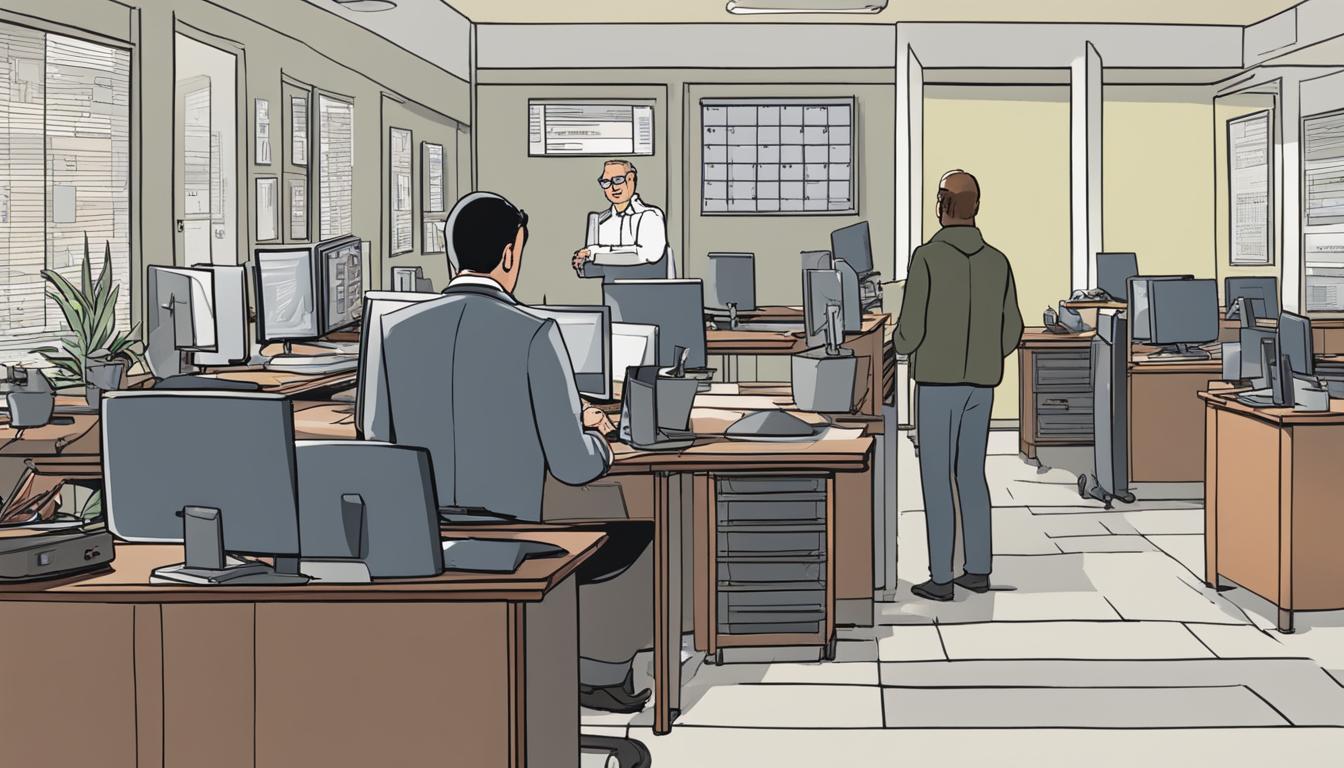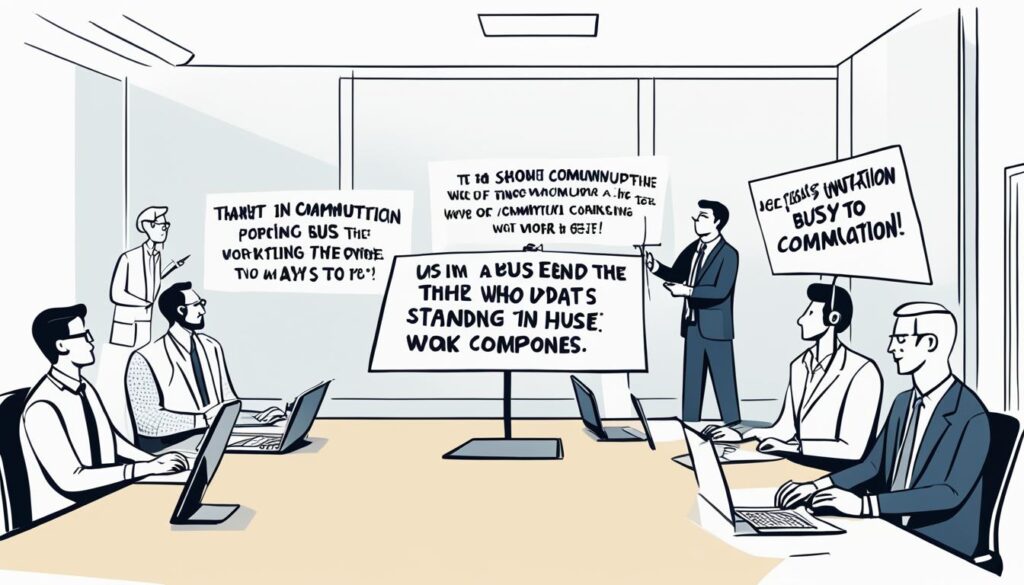When I am eagerly waiting for an update, the words I choose to inquire about it can greatly impact the response I receive. I want to convey my curiosity without sounding pushy or demanding. In this article, I will explore a variety of polite and effective ways to ask for updates. By diversifying our approach, we can foster better communication and strengthen professional relationships.
Key Takeaways:
- Choose simple and direct phrases when requesting an update to effectively convey your curiosity.
- Using polite and passive language can maintain professionalism while expressing your desire for an update.
- Lowering the stakes and requesting a quick update can keep the communication light and efficient.
- Offering assistance to the recipient can increase the chances of receiving a comprehensive update.
- A follow-up email can provide peace of mind when waiting for an update and reduce anxiety.
Simple and Direct Requests
In the quest for an update, simplicity can often be the key to success. By using a direct and straightforward approach, you can effectively communicate your request without sounding overly demanding or impatient. Instead of asking a generic “do you have an update?”, consider using phrases that convey your message clearly and respectfully.
For instance, you could say something like:
“Can you please update me on the progress?”
This simple yet polite request demonstrates your interest in receiving an update without putting unnecessary pressure on the recipient. It conveys your expectation for an update while maintaining a considerate tone.
If you prefer a slightly softer approach, another option could be:
“Would it be possible to receive an update regarding [specific topic or task]?”
By specifying the topic or task you are inquiring about, you provide clarity and direction, which can help the recipient understand your request more effectively. This approach shows that you value their time and are genuinely interested in staying informed.
When making these simple and direct requests, it’s essential to consider your relationship with the person you are asking for an update. If you’re communicating with colleagues or team members, a more informal tone may be appropriate. However, in formal client communication, it’s important to maintain a professional and respectful tone.
| Phrase | Usage |
|---|---|
| “Can you please update me on the progress?” | A direct and polite request for a progress update. |
| “Would it be possible to receive an update regarding [specific topic or task]?” | A more specific request seeking an update regarding a particular topic or task. |
Polite and Passive Language
In the quest to request an update, employing a passive approach using polite language can yield remarkable results. By using phrases like “Would you kindly give me an update?” or “I wanted to see how things were going,” one can convey their request in a professional and courteous manner. These expressions work exceptionally well when dealing with individuals whom you have an established relationship with or in more formal business settings.
“Would you kindly give me an update?”
Employing polite language not only shows respect but also helps to maintain positive professional relationships. When requesting an update using such language, it creates a sense of collaboration rather than making demands. This passive approach can foster a more harmonious work environment, enabling open and constructive communication between colleagues.
Building Rapport through Polite Language
Polite and passive language can go a long way in building rapport and fostering strong professional bonds with colleagues or clients. It demonstrates a commitment to maintaining an amicable relationship while ensuring everyone feels comfortable and valued in their interactions.
- When using a polite tone, be mindful of your choice of words so they don’t come across as condescending or insincere.
- Consider the context and relationship with the recipient before using passive language. It may not be suitable in all situations.
- Remember that tone is essential in written communication, so focus on conveying your request respectfully and sincerely.
By incorporating polite and passive language into your update requests, you can navigate professional settings with grace and establish a strong foundation for effective communication.
Here’s an example of how you can politely request an update:
“Dear [Recipient’s Name],
I hope this email finds you well. I wanted to reach out and kindly request an update on the [project/task]. I understand that you may be busy, but any information you can provide would be greatly appreciated. Thank you for your attention to this matter.
Best regards,
[Your Name]”
Lowering the Stakes
When it comes to asking for updates, sometimes it’s better to lower our expectations and request a quick update instead of a detailed one. By using phrases like “Can you please give me a quick update?” we imply that we are not expecting a lengthy response but rather a brief update on the progress. This approach is effective when we want to keep the communication light and less time-consuming for both parties.
Requesting a quick update can be beneficial in situations where time is of the essence or when we simply want to stay informed without overwhelming the recipient. By using concise language and setting realistic expectations, we can maintain a productive and efficient dialogue. A quick update allows us to stay in the loop and adjust our plans or expectations accordingly.
It’s important to remember that a quick update doesn’t mean sacrificing the quality or accuracy of the information provided. Even in a brief update, we can still expect relevant details that help us understand the current status or progress of the project. The key is to frame our request in a way that demonstrates our understanding of the time constraints while conveying our need for at least a basic update.
Sample Script: Requesting a Quick Update
Dear [Recipient’s Name],
Hope you’re doing well! I wanted to kindly request a quick update on [specific task or project]. As we approach the deadline, it would be great to have a general sense of the progress made so far. I understand that time is limited, so a brief update would be highly appreciated. It will help me align my plans and expectations accordingly.
Thank you for your attention to this matter, and I look forward to hearing from you soon.
| Benefits of Requesting a Quick Update |
|---|
| 1. Time-efficient communication |
| 2. Maintaining awareness of project progress |
| 3. Adjusting plans and expectations accordingly |
| 4. Avoiding unnecessary delays or misunderstandings |
Offering Assistance
Asking for updates can sometimes feel like a one-sided conversation, but offering your assistance can change the dynamic and increase the likelihood of receiving a detailed response. By showing your willingness to help, you not only support the recipient but also foster a collaborative environment. So, if you genuinely mean it, don’t hesitate to ask, “Can I help in any way?”
Offering assistance not only demonstrates your commitment but also shows that you value the recipient’s progress and want to contribute constructively. The recipient may appreciate your offer and provide a more comprehensive update, knowing that they have someone they can rely on.
Remember, it’s important to be sincere in your offer and be prepared to follow through on your promise. If the recipient does accept your help, be ready to lend a hand and support them in any way you can. By offering assistance, you create an opportunity to build trust and strengthen your professional relationships.
Emphasize your willingness to collaborate and showcase your dedication to the recipient’s success. By doing so, you position yourself as a valued ally, someone they can turn to for support and assistance.
| Technique | Example |
|---|---|
| Expressing Availability | “If there’s anything I can do to help, please let me know.” |
| Offering Specific Skills | “I have experience with [specific task]. Would you like me to assist you with it?” |
| Proposing Collaboration | “I think our strengths complement each other. Shall we tackle this together?” |
| Providing Resources | “I’ve found some helpful articles that might assist with [topic]. Would you like me to share them?” |
Remember, while it’s good to offer assistance, it’s equally crucial to respect boundaries and not overwhelm the recipient. Find the right balance and only offer help that you can genuinely provide.
By offering your assistance, you not only increase the chances of receiving a detailed update but also create a collaborative environment where everyone can thrive. So, don’t hesitate to extend a helping hand and show your support.
Testimonials:
“When I offered my assistance, my colleague appreciated it and provided me with a detailed update. It made me feel valued and reinforced our collaborative work dynamic. I highly recommend offering help to get the updates you need.”
– Jane Smith, Marketing Manager
- Offering your help can create a positive impression and strengthen your professional relationships.
- When offering assistance, be sincere and ready to follow through on your promise.
- Use specific phrases to show your availability, offer your skills, propose collaboration, or provide relevant resources.
- Balance your willingness to help with respect for the recipient’s boundaries.
Seeking Peace of Mind
Waiting for an update can be an overwhelming experience, particularly when a promised deadline has passed. The anticipation and uncertainty can often lead to anxiety and stress. If you find yourself in this situation, there is a simple solution to ease your worries and bring you peace of mind – sending a follow-up email.
By politely reaching out and requesting an update, you take control of the situation and gain a sense of reassurance. It allows you to communicate your expectations clearly and seek clarification on the timeline or status of the update. Taking proactive steps to seek an update not only reduces anxiety but also demonstrates your commitment and professionalism.
When crafting your follow-up email, keep in mind that politeness and tact are essential. Here’s an example of a well-worded email:
Dear [Recipient’s Name],
I hope this email finds you well. I wanted to follow up on the progress of [project/task] that we discussed earlier. As the deadline has passed, I am seeking an update on the current status and timeline.
Your prompt response would be greatly appreciated, as it would provide me with the necessary information to plan my next steps accordingly. Please let me know if there are any challenges or additional details that you require from my end.
Thank you for your attention to this matter.
Sincerely,
[Your Name]
The above email strikes a balance between being polite and assertive, effectively conveying your need for an update while maintaining professionalism. By following up, you not only reduce your anxiety about the update but also demonstrate your proactive approach to staying informed and focused.
The key is to approach your follow-up email with confidence and clarity. Remember, seeking an update is your right, and by doing so, you empower yourself with the information needed to move forward and make informed decisions.
Adding Value with Further Insight
When sending a follow-up email, it’s not just an opportunity to ask for an update, but also a chance to showcase your expertise and provide additional value to the recipient. Sharing relevant ideas and insights related to the project or task can demonstrate your commitment to the role and your ability to contribute effectively.
By offering further insights, you can highlight your knowledge in the field and present yourself as a valuable asset to the team. This approach is especially useful when you realize there is more information or suggestions that you forgot to mention during the initial conversation.
“The true value of communication lies not in what you say, but in what others understand.”
By taking the time to think critically about the project or task at hand, you can provide fresh perspectives and innovative ideas that may benefit the recipient. Sharing your unique insights shows that you are invested in the project’s success and willing to go the extra mile.
Table 7.1: Additional Ideas and Insights
| Ideas | Benefits |
|---|---|
| Integrating social media marketing | Increase brand visibility and engagement |
| Implementing automation tools | Streamline processes and increase efficiency |
| Exploring new target audiences | Expand market reach and uncover untapped opportunities |
| Utilizing data analytics for decision-making | Improve strategic planning and achieve better outcomes |
These additional ideas and insights can create a more dynamic and collaborative conversation. They showcase your dedication to delivering high-quality results and your ability to think beyond the surface level.
Remember, the goal is not to overwhelm or dictate but to provide value and stimulate discussion. By offering further insights and ideas, you demonstrate your willingness to contribute to the project’s success and establish yourself as a trusted and knowledgeable professional.
Nudging the Process Forward
In situations where you find yourself in the exciting yet nerve-wracking position of receiving another job offer while eagerly awaiting a response from your preferred employer, a well-crafted follow-up email can be the key to nudging the decision-making process in your favor.
Politeness and tact are paramount when composing this crucial follow-up, as you want to convey your continued interest in the position while respecting the hiring manager’s time and decision-making process. Consider mentioning the job offer you have received, highlighting the urgency in making a decision without pressuring or demanding an immediate response.
Express your sincere enthusiasm for the coveted role and emphasize your eagerness to contribute to the company’s success. By doing so, you not only demonstrate your interest, but you also create a sense of urgency that may prompt the hiring manager to expedite the hiring process.
It’s essential to strike a delicate balance between asserting your candidacy and remaining respectful, as you don’t want to come across as pushy or impatient. Remember, employers appreciate candidates who are patient yet passionate about the opportunity.
Don’t be afraid to showcase your unique value proposition in this follow-up email. Briefly outline the key strengths or qualifications that make you an ideal fit for the role. By doing so, you provide the hiring manager with a subtle reminder of why they should choose you over other candidates.
Sample Follow-up Email:
Dear [Hiring Manager’s Name],
I hope this email finds you well. I wanted to reach out and express my continued interest in the [Job Title] position at [Company Name].
Since our last correspondence, I have had the honor of receiving another job offer. This opportunity has emphasized the importance of making a well-informed decision regarding my career path.
I must reiterate my sincere passion for the role at [Company Name]. The company’s values, mission, and innovative approach to [industry/sector] align perfectly with my own professional aspirations.
I genuinely believe that my expertise in [relevant skill or experience] and my dedication to [specific value or responsibility] would enable me to make a significant impact within your organization. I am excited about the possibility of contributing to your team and driving [Company Name] towards continued success.
I understand the complexity involved in the decision-making process and respect the time it takes to reach a final verdict. However, I wanted to express my ongoing interest and remind you of my availability for any additional discussions or interviews that may further inform your decision.
Thank you for considering my application thus far. I eagerly await your response and the opportunity to join your esteemed team.
Sincerely,
[Your Name]
By gracefully nudging the process forward with a follow-up email that exudes your genuine interest and enthusiasm, you increase your chances of expediting the decision-making process. Remember, a well-timed and thoughtfully crafted follow-up can make all the difference in landing your dream job.
Overcoming Fear of Following Up
Fear of following up can prevent many job seekers from taking necessary action in their job search. However, it’s important to recognize that following up can actually have numerous benefits and help propel your job search forward.
First and foremost, following up provides peace of mind. Waiting anxiously for a response can be stressful, but by reaching out and requesting an update, you can gain clarity and alleviate the uncertainty that often accompanies the waiting period.
Moreover, following up presents an opportunity to showcase your qualifications and stand out from the competition. By sending a thoughtful and well-crafted follow-up email, you can remind the hiring manager of your skills, experiences, and enthusiasm for the position. This not only keeps you on their radar but also reinforces your commitment to the role.
Lastly, following up can help move the hiring process forward. Your follow-up email can serve as a gentle nudge to the employer, demonstrating your continued interest in the position and prompting them to take action. It shows your proactive nature and can even expedite the decision-making process, making it a valuable strategy in a competitive job market.
FAQ
What are some other ways to ask for an update?
There are several alternatives to asking ‘do you have an update?’ One way is to make a simple and direct request using phrases like “Can you please update me?” or “Would it be possible to receive an update?”. Another option is to use polite and passive language, such as “Would you kindly give me an update?” or “I wanted to see how things were going”. You can also lower the stakes by requesting a quick update instead of a detailed one with phrases like “Can you please give me a quick update?”. Offering your assistance can increase the chances of receiving a comprehensive update, for instance by asking “Can I help in any way?”.
How can I ask for an update without sounding demanding?
To avoid sounding demanding, it’s important to use polite and professional language in your request for an update. You can make a simple and direct request using phrases like “Can you please update me?” or “Would it be possible to receive an update?”. Additionally, using polite and passive language, such as “Would you kindly give me an update?” or “I wanted to see how things were going”, can convey your request in a more respectful manner.
How can I request a quick update?
If you prefer a quick update instead of a detailed one, you can use phrases like “Can you please give me a quick update?” or “Just checking in for a brief update”. These phrases indicate that you don’t expect a lengthy response but rather a concise update on the progress.
How can offering assistance help in getting a comprehensive update?
By offering your assistance to the recipient, you show that you are willing to support and collaborate with them. This can make them more likely to provide a detailed and comprehensive update. You can ask “Can I help in any way?” or “Is there anything I can do to support you?”. However, it’s important to only offer help if you genuinely mean it and are ready to follow through on your offer.
What should I do if I’m waiting for an update and a promised deadline has passed?
If a promised deadline has passed, it’s appropriate to send a follow-up email politely asking for an update. You can mention the original deadline and request an update on the timeline or status. This follow-up email can provide you with peace of mind and help alleviate some of the stress associated with waiting for a response.
How can I add value in a follow-up email?
In a follow-up email, you can add value by offering further insights or ideas related to the project or task. This can demonstrate your knowledge, expertise, and commitment to the role. For example, you can share additional information or suggestions that you may have forgotten to mention during the initial conversation or interview.
How can a follow-up email nudge the hiring process forward?
If you’ve received another job offer but are still waiting to hear from your preferred employer, a follow-up email can nudge the hiring manager to make a decision. You can politely mention the job offer and express your continued interest in the position. This creates a sense of urgency and may expedite the hiring process.
Why should I follow up even if I’m afraid of appearing pushy?
Following up can have several benefits, including peace of mind, the opportunity to showcase your qualifications, and the ability to move the process forward. It’s important to understand the importance of following up and use appropriate language and timing. By overcoming the fear of following up, you can navigate the job search process more effectively.
Source Links
- https://languagetool.org/insights/post/word-choice-i-just-wanted-to-follow-up/
- https://www.themuse.com/advice/how-following-up-can-help-you-land-the-job
- https://weareindy.com/blog/what-is-the-best-way-to-politely-request-an-update-from-your-client-with-email-samples













